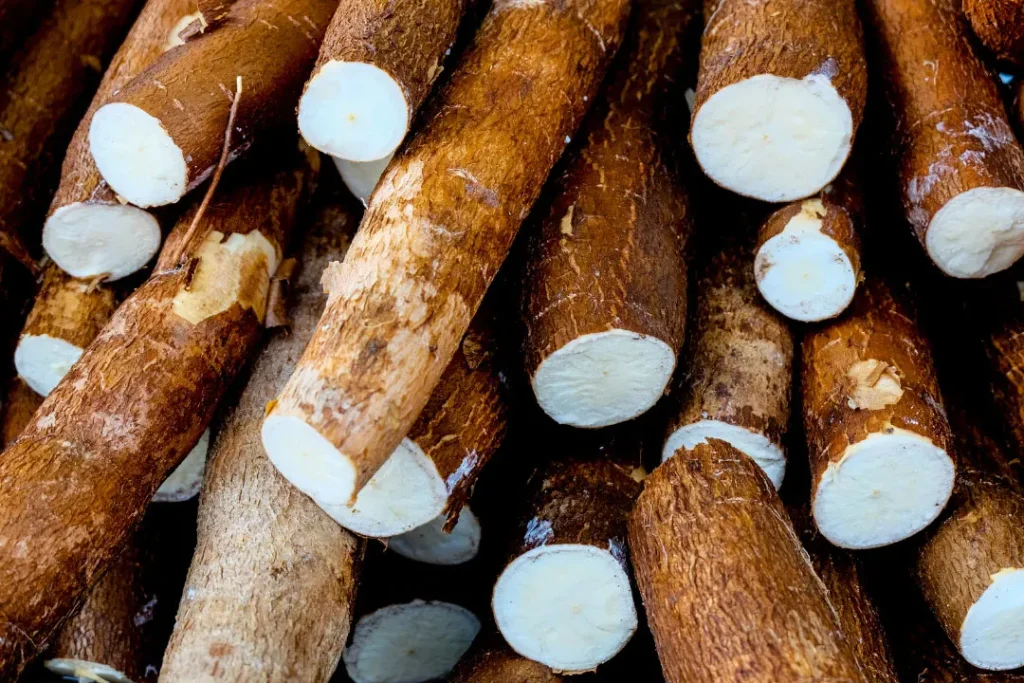The root vegetable known as cassava or Manihot esculenta, in botanical terms, is indigenous to South America. Due to its high carbohydrate content and ability to thrive in a variety of ecological situations, it is extensively cultivated in the tropics and subtropics and is a staple meal for almost half a billion people globally. The range of bioactive chemicals found in cassava provides additional potential health advantages.
You May Also Like:
Should You Try CBD for Focus? Here Are the Facts.
5 Great Health Benefits of ElevATP: From Increased Energy to Better Brain Function…
Nature of Cassava
Dietary fiber and important vitamins and minerals including vitamin C, thiamine, riboflavin, and niacin are abundant in cassava. Alkaloids, flavonoids, and saponins, which are minor components of cassava with antioxidant capabilities, are also present.
Particularly saponins have shown advantages in preserving gut health and enhancing the immune system. They work by creating compounds with bile salts and cholesterol, which decreases their absorption. Alkaloids and flavonoids also have antioxidant capabilities that help scavenge free radicals and lessen oxidative stress.

Health Benefits of Cassava
- Nutritional value: A 100-gram portion of cassava contains around 38 grams of carbs, which makes up the majority of its weight. Because of its high carbohydrate content, it is a fantastic source of energy, particularly in poor nations where people need to eat foods that are rich in energy to satisfy their high daily energy needs.
- Dietary fiber: Cassava is a good source of dietary fiber, especially resistant starch, which is associated with various health advantages. As a prebiotic, resistant starch improves gut health by encouraging the development of good bacteria in the stomach. Additionally, it improves satiety and controls blood sugar levels.
- Antioxidant properties: Cells are shielded from reactive oxygen species damage by the bioactive chemicals in cassava, which have antioxidant capabilities. This raises the possibility of lowering the risk of chronic illnesses including cancer and heart disease.

Chemistry of Cassava
The main chemical components of cassava may be separated into primary and secondary metabolites. Carbohydrates (primarily starch), proteins, and lipids are examples of primary metabolites, while substances like phenols, flavonoids, tannins, and cyanogenic glycosides are examples of secondary metabolites.
The primary carbohydrate in cassava, starch, is arranged in granules that differ in size, shape, and crystallinity, which helps to explain its distinctive physicochemical characteristics. Because of these qualities, cassava starch is widely sought-after in a variety of industrial applications, including those in food, textiles, and medicines.
The most important secondary metabolites in cassava are cyanogenic glycosides, including linamarin and lotaustralin, which help the plant defend itself against herbivores. If cassava is not properly processed, these chemicals may form cyanide when consumed and this might pose health problems.
Physiological Mechanisms of Action of Cassava
Because of its high carbohydrate content and bioactive secondary metabolites, cassava is thought to have physiological benefits.
- Energy Supply: Cassava is a rich source of carbohydrates that provide the body with glucose, which is the body’s main source of energy for cells. In the digestive tract, cassava starch is broken down into glucose, which is subsequently absorbed and utilized by cells during a process known as cellular respiration to produce energy.
- Gut Wellness: Resistant starch in cassava’s dietary fiber in particular travels undigested to the colon, where it acts as a substrate for the gut flora. These bacteria convert resistant starch into short-chain fatty acids (SCFAs), such as acetate, propionate, and butyrate, which have a number of positive health effects. Butyrate in particular possesses anti-inflammatory and anticancer effects which gives colon cells energy.
- Detoxification Process: The body has a built-in detoxification process to cope with low amounts of cyanide exposure, which is relevant to the cyanogenic glycosides in cassava. By transforming cyanide into thiocyanate, a less harmful substance that can be eliminated in the urine, the enzyme rhodanese aids in the detoxification of cyanide.
- Protection from Oxidative Damage: The flavonoids in cassava have antioxidant properties by scavenging free radicals and reactive oxygen species, preventing oxidative damage to human cells. It is possible that the antioxidant activity may guard against long-term conditions like cancer and cardiovascular disease.

Optimal Dosage of Cassava
Although cassava has several health advantages, it’s vital to weigh out any possible health hazards before consuming it. When consumed, cyanogenic glycosides found in raw cassava may result in the production of dangerous cyanide. To lower the cyanide content of cassava to acceptable levels, it should always be properly processed—typically by soaking, heating, or fermenting.
Due to differences in dietary habits and cultural customs, determining the ideal dose for consuming cassava is difficult. It is often eaten as a food source in modest quantities, however, this might vary according to a person’s specific nutritional and calorie requirements. However, consuming too much cassava, particularly when it has been incorrectly processed, may result in cyanide poisoning, which can cause more serious symptoms including paralysis and nerve damage in addition to vomiting and gastrointestinal discomfort.
Side Effects of Cassava
The cyanogenic glycosides linamarin and lotaustralin, which are largely found in raw and badly cooked cassava, may cause the body to create cyanide. As mentioned, consuming large quantities of inadequately processed cassava may cause acute cyanide toxicity, which manifests as nausea, vomiting, headaches, disorientation, and, in extreme circumstances, paralysis.
Long-term ingestion of inadequately processed cassava is linked to chronic health problems in addition to acute toxicity. Constant, low-level cyanide exposure from eating cassava may result in konzo, a neurological condition that causes permanent limb paralysis. The excessive intake of improperly processed cassava has also been linked to iodine deficiency illnesses owing to cyanide’s interference with iodine absorption as well as tropical ataxic neuropathy, a neurological ailment.
Furthermore, communities that rely significantly on cassava as a major food source may develop protein-energy malnutrition due to the low protein content and poor protein quality of cassava.

Potential Substance Interactions with Cassava
The possible interactions of cassava with other drugs are mainly unexplored. However, due to its high fiber content and the possibility that certain nutrients might impede absorption, cassava may potentially interfere with medicines whose effectiveness depends on nutritional intake. Therefore, before including a lot of cassava in your meals, if you are taking any drugs with special dietary needs, you should talk to your doctor.
Best Responsible Uses of Cassava
When utilizing cassava as a food source or nutritional supplement, optimal procedures must be followed due to the possible dangers. Cassava preparation and processing must be done correctly to eliminate cyanogenic chemicals for safe ingestion.
- Processing and preparation: Using age-old techniques including soaking, boiling, and fermentation which were shown to be successful in lowering the cyanide concentration of cassava. These should be closely adhered to, particularly when ingesting bitter cultivars known to have greater levels of cyanogenic glycosides.
- Dietary Diversification: Cassava is a great source of carbs, but since it contains little protein and lacks several crucial elements, it shouldn’t be the only or main source of nourishment. Incorporating cassava into a diverse diet aids in achieving a balanced diet.
- Use as a nutritional supplement: Cassava is normally sold as flour or as a supplement that contains many vitamins and minerals. To prevent possible health hazards, it is essential to take the medication as directed by the manufacturer and to speak with a healthcare professional.
- Cassava flour is a great substitute for individuals who have celiac disease or gluten sensitivity in cooking since it is gluten-free. It may be used in place of wheat flour in baking and cooking.
In conclusion, when ingested properly, cassava has numerous nutritional advantages. However, it’s important to utilize this tuber properly because of the possible health hazards connected to poor preparation and excessive ingestion. A diversified and balanced diet is essential to maintaining good health and nutrition, just as with other food sources.

Cassava:
Conclusion
Considering the health benefits of cassava supplements, they can be a valuable addition to your wellness regimen. Cassava is a root vegetable and its indigenous origins are in South America. Cassava supplements have high dietary fiber and nutritional value, which contributes to good gut health and daily energy requirement. The natural metabolites found in cassava support its industrial use in food and medicines. However, it is important for you to understand unfavorable side effects due to overdose and determine the appropriate dosage by seeking advice from a doctor. You should also select reputable sellers to ensure product quality and reliability.
References:
- “Cassava Intake and Vitamin A Status Among Women and Preschool Children in Akwa-Ibom, Nigeria.” Retrieved from: https://www.plosone.org/article/info%3Adoi%2F10.1371%2Fjournal.pone.0129436
- “Dietary Cyanogen Exposure and Early Child Neurodevelopment: An Observational Study from The Democratic Republic Of Congo”. Retrieved from: https://www.ncbi.nlm.nih.gov/pmc/articles/PMC5903613/
- “Ethnopharmacological Values of Cassava and Its Potential for Diabetes and Dyslipidemia Management: Knowledge Survey and Critical Review of Report.” Retrieved from: https://www.ncbi.nlm.nih.gov/pmc/articles/PMC5580950/#:~:text=Yet%2C%20it%20is%20known%20that,including%20heart%20disease%20%5B10%5D.
Important Note: The information contained in this article is for general informational purposes only, and should not be construed as health or medical advice, nor is it intended to diagnose, prevent, treat, or cure any disease or health condition. Before embarking on any diet, fitness regimen, or program of nutritional supplementation, it is advisable to consult your healthcare professional in order to determine its safety and probable efficacy in terms of your individual state of health.
Regarding Nutritional Supplements Or Other Non-Prescription Health Products: If any nutritional supplements or other non-prescription health products are mentioned in the foregoing article, any claims or statements made about them have not been evaluated by the U.S. Food and Drug Administration, and such nutritional supplements or other health products are not intended to diagnose, treat, cure, or prevent any disease.


